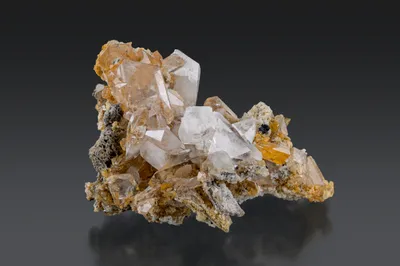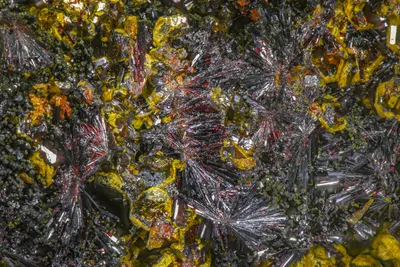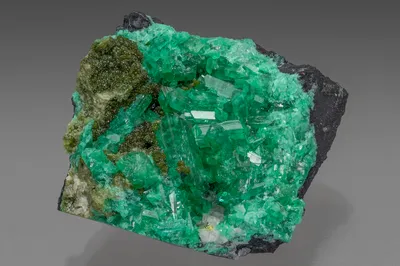Mineral Species
Chenevixite
Type Locality
No
Composition
Cu2+2Fe3+2(AsO4)2(OH)4·H2O
Crystal System
Monoclinic
Status at Tsumeb
Confirmed
Abundance
Very rare
Distribution
First, second (?) and third oxidation zones
Paragenesis
Supergene
Entry Number
Species; TSNB80
General Notes
Chenevixite was reported from the first oxidation zone by Maucher (1908a,b), but confirmed by modern analysis only relatively recently (Krahn 2010). Maucher (1908a,b) reported chenevixite from the early bulk samples shipped to Frieberg from Tsumeb for metallurgical testwork. He described grass-green to olive-green masses but commented that he was unable to obtain a pure sample. He also suggested that a spongy, brownish, lead-bearing material was closely related to chenevixite. Pinch and Wilson (1977) later referred to the latter as ‘Pb-chenevixite’.
Significantly, chenevixite is missing from the lists of first oxidation zone arsenates provided by Klein (1938), Bürg (1942) and Strunz and Tennyson (1967), implying that it was either extremely rare or possibly that it had been mis-identified by Maucher (1908a,b) who, by his own admission, failed to isolate a pure sample for analysis.
Bartelke (1976) and Pinch and Wilson (1977) included chenevixite in their lists of minerals occurring at Tsumeb, but apparently based solely on Maucher’s (1908a,b) identification and description.
Lombaard et al. (1986) listed chenevixite as an extremely rare mineral, but with no further comment.
Keller’s (1977, 1984) paragenetic studies were based almost entirely on second oxidation zone specimens, so that the inclusion of chenevixite in his paragenetic scheme (Keller 1984) provides circumstantial evidence of its occurrence in the second oxidation zone.
Keller (1984) described yellow-green fibrous aggregates of chenevixite and flagged the potential for it to be confused with ‘Mineral TK’ [= gartrellite]. He suggested that chenevixite may be more common than estimated by previous authors, and that it is part of a paragenesis forming at relatively low pH which includes minerals such as anglesite, arsentsumebite, brochantite, carminite and scorodite.
Krause (1995) described the 1994 discovery of a vug on 44 Level in the third oxidation zone containing microcrystalline chenevixite, associated with conichalcite, ferrilotharmeyerite, silver-amalgam and zincolivenite (see also Gebhard and Schlüter 1995; Gebhard 1999).
Associated Minerals
anglesite; arseniosiderite; arsentsumebite; brochantite; carminite; conichalcite; euchroite (?); eugenite; ferrilotharmeyerite; gartrellite; malachite; olivenite; quartz; scorodite; silver; zincolivenite







